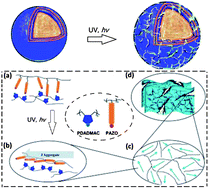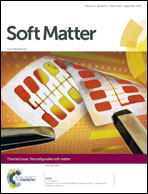UV-induced disruption of microcapsules with azobenzene groups
Abstract
UV responsive microcapsules containing azobenzene were fabricated by sequential deposition of oppositely charged poly[1-[4-(3-carboxy-4-hydroxyphenylazo)benzenesulfonamido]-1,2-ethanediyl, sodium salt] (PAZO) and poly(diallyldimethyl ammonium) chloride (PDADMAC). As found in this work, combination of PDADMAC and PAZO led to aggregation of PAZO segments in the progress of polymer deposition, which facilitated the large extent of J aggregates when the capsules were exposed to UV light. J aggregate assemblies destroyed the integrity of capsule shell formations, demonstrating capsule swelling and further breakage. This UV induced capsule breakage offered a new way to modulate the release of encapsulated cargos.

- This article is part of the themed collection: Reconfigurable soft matter

 Please wait while we load your content...
Please wait while we load your content...